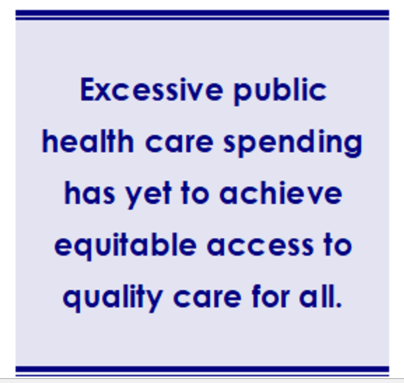You can also view this newsletter as a PDF.

California Leaders Seek to Address Cost Barriers
and Inequities in Health Care Delivery System
The U.S. national health care system — from how it is funded, to how it provides care and pharmaceuticals — is operationally and administratively complicated. The result is that health care spending is on a constant upward trajectory. In turn, the high cost of care impedes access, especially for low-income and uninsured Americans. These inequities were exposed and exacerbated by the COVID-19 pandemic.
Cost and bureaucratic barriers cause many to delay or skip preventive and chronic care, or to not purchase and take needed medications. Although access to health care insurance in California has improved since enactment of the 2010 Affordable Care Act, costs continue to rise.
 The U.S. spends more on health care as a percentage of its GDP than any other country in the world. In 2016, total national health care spending amounted to $3.4 trillion, or 18.1 percent of that year’s $18.5 billion GDP. By 2020, spending grew by 9.7 percent, reaching $4.1 trillion—or $12,530 per person—and accounting for 19.7 percent of the nation's GDP. The share of GDP spent on health care is expected to reach 20 percent by 2025.
The U.S. spends more on health care as a percentage of its GDP than any other country in the world. In 2016, total national health care spending amounted to $3.4 trillion, or 18.1 percent of that year’s $18.5 billion GDP. By 2020, spending grew by 9.7 percent, reaching $4.1 trillion—or $12,530 per person—and accounting for 19.7 percent of the nation's GDP. The share of GDP spent on health care is expected to reach 20 percent by 2025.
In his book “Priced Out: The Economic and Ethical Costs of American Health Care,” Uwe E. Reinhardt observes that the Milliman Index, which tracks out-of-pocket spending by families, shows health care costs for a family of four rising from $8,414 a year in 2001 to $25,826 by 2016. Californians spend approximately $485 billion a year on public and private health care.
Even large employer purchasers of health care — including the California Public  Employees’ Retirement System (CalPERS) Board on which Controller Yee sits — struggle to keep their beneficiaries’ health care costs down. According to Kristof Stremikis, director of Market Analysis and Insight for the California Health Care Foundation, who spoke at CalPERS’ January 2022 board meeting, about half of Californians struggle with affording health care. This is not surprising, given that monthly health care plan premiums in Californian are higher than the national average. Niall Brennan, president and CEO of the Health Care Cost Institute, added that California ranks 30th in state spending on health care.
Employees’ Retirement System (CalPERS) Board on which Controller Yee sits — struggle to keep their beneficiaries’ health care costs down. According to Kristof Stremikis, director of Market Analysis and Insight for the California Health Care Foundation, who spoke at CalPERS’ January 2022 board meeting, about half of Californians struggle with affording health care. This is not surprising, given that monthly health care plan premiums in Californian are higher than the national average. Niall Brennan, president and CEO of the Health Care Cost Institute, added that California ranks 30th in state spending on health care.
Excessive national, state, private, and public health care spending has yet to achieve equitable access to quality care for all, underscoring why so many advocate for a government-run single-payer health care delivery system.
Other countries have systems based on heavily regulated government-funded social insurance covering 90-95 percent of the population, with uniform fee schedules and rules, and a small private insurance market for high-income households. The uniformity helps keep costs in check and allows for more equitable access to care. Several such systems are explored in “Essentials of Health Policy and Law 4th Edition.”
 Great Britain, for example, has the largest publicly funded national health system in the world. Most of its citizens access free health care — without co-pays or premiums — through registered general practitioners, many of whom work for the National Health Service of England (NHS) as independent contractors. The NHS owns the hospitals, and their staff are employees. Approximately 10 percent of the population also has private insurance which affords more convenient and often more timely access to care, particularly from specialists.
Great Britain, for example, has the largest publicly funded national health system in the world. Most of its citizens access free health care — without co-pays or premiums — through registered general practitioners, many of whom work for the National Health Service of England (NHS) as independent contractors. The NHS owns the hospitals, and their staff are employees. Approximately 10 percent of the population also has private insurance which affords more convenient and often more timely access to care, particularly from specialists.
Due to these minimal barriers to accessing care, Great Britain’s system has been very successful in improving health and life expectancy. Its direct system differs from medical billing in the U.S. in complexity, but even this has not fully reined in costs. In fact, this system has long operated with a deficit. Moreover, while all British people have ready access to general health care, the wait for specialized services can often take two months or longer.
The NHS, like CalPERS, is always exploring and testing new strategies to manage ongoing cost increases — including capping provider payments, increasing use of generic drugs, reducing hospital payments, and lowering approved administrative costs — all while trying to improve health outcomes and quality of care.
 In Canada, the federal government provides prescription drug benefits and public health services under a single taxpayer funded system. Hospitals negotiate budgets with their respective regional health authorities or the National Ministry of Health. Regional health authorities organize care delivery, hire acute care facility staff, reimburse hospitals and doctors through fee-for-service arrangements, and contract out for ambulatory care service providers. Additional care options are available with private insurance.
In Canada, the federal government provides prescription drug benefits and public health services under a single taxpayer funded system. Hospitals negotiate budgets with their respective regional health authorities or the National Ministry of Health. Regional health authorities organize care delivery, hire acute care facility staff, reimburse hospitals and doctors through fee-for-service arrangements, and contract out for ambulatory care service providers. Additional care options are available with private insurance.
Under Germany’s social health care system, decision-making powers are shared  among federal and state governments and self-regulated organizations of payers and providers. Germany’s federal government has wide-ranging regulatory power over health care, but is not directly involved in care delivery.
among federal and state governments and self-regulated organizations of payers and providers. Germany’s federal government has wide-ranging regulatory power over health care, but is not directly involved in care delivery.
Germans must enroll in regional nonprofit “sickness funds” which are funded by employer and employee contributions. Higher earners may opt out and pay higher fees for private insurance, with options much like those available through Covered California. The sickness funds provide standard benefit packages including inpatient and outpatient services and prescription medications. Contributions are pooled and reallocated to individuals based on a risk-adjusted formula that accounts for age, sex, and morbidity. Physicians are in private practice, but they negotiate with the fund. Hospital employees are salaried and are split between public, private, and nonprofit.
Those who earn less than $60,000 per year — as well as pensioners, students, unhoused individuals, and people with disabilities — are covered by the sickness funds.
Germany’s Federal Joint Committee (FJC), which is supervised by the federal Ministry of Health, determines the services to be covered by nonprofit regional sickness funds. To the extent possible, coverage decisions are based on evidence from comparative-effectiveness reviews and health technology risk-benefit assessments. The FJC also sets quality measures for providers and regulates ambulatory care capacity using needs-based population-physician ratios.
There have been recent efforts to address rising costs and inequities in California’s  health care delivery system — including attempts to enact a transition informed by the successes of these other countries — but risks and up-front costs have proven to be formidable barriers. Governor Newsom is making some headway in addressing the administrative complexity of care delivery under the federal Medicaid program (Medi-Cal).
health care delivery system — including attempts to enact a transition informed by the successes of these other countries — but risks and up-front costs have proven to be formidable barriers. Governor Newsom is making some headway in addressing the administrative complexity of care delivery under the federal Medicaid program (Medi-Cal).
The Department of Health Care Services’ California Advancing and Innovating Medi-Cal (CalAIM) program intends to improve care coordination, providing more services to those with chronic conditions and other complex needs such as drug addiction or lack of housing. First introduced in the FY 2020-21 State Budget, CalAIM changes the existing county-by-county fee-for-service model into a regionally priced managed-care model with social service coordination.
Based on assessments of earlier program pilots, DHCS envisions CalAIM‘s standardization eliminating current cost inconsistencies across the state. Proponents believe this will help incentivize plans to identify new and less costly ways to achieve desired health care outcomes in a way standard fee-for-service models have not.
The nonpartisan Legislative Analyst’s Office (LAO) cautions that long-term oversight is critical to ensure the program's cost-effectiveness outweighs the inherent risks. LAO also questions whether CalAIM will succeed in expanding managed care plans’ responsibilities to include coordination with community-based organizations on social issues tied to wellness, such as housing assistance.
Separately, Assemblymember Ash Kalra attempted a broader effort this year to address health care costs and access barriers in his single-payer “CalCare” proposal, Assembly Bill 1400, and its constitutional funding mechanism, ACA 11. In a May 2022 letter to Assembly Rules Committee members, LAO questioned whether statewide health care expenditures would be lower under CalCare, acknowledging this would depend heavily on its impact to service utilization levels and availability of care. LAO noted transitioning to a predominately publicly funded program could cost the state anywhere from $70 billion to $193 billion a year.
AB 1400 proposed making health care free to all, including the currently uninsured, in order to increase utilization. As it did in England, increasing utilization could add to program costs. More problematic was the bill’s proposed elimination of the managed-care approach, a key foundation of Governor Newsom’s CalAIM program.
LAO pointed out that the managed-care model is believed by many to be a tool to control utilization. Others argue that fee-for-service is not the primary cause of rising costs, blaming instead the profit-seeking role of publicly traded health insurers and the rising trend of private equity involvement.
 While cost savings could occur if the state had more control over reimbursement costs for doctors, facilities, medical products and devices, and prescription drugs, these controls could have the unintended consequence of affecting the quantity and quality of available health care.
While cost savings could occur if the state had more control over reimbursement costs for doctors, facilities, medical products and devices, and prescription drugs, these controls could have the unintended consequence of affecting the quantity and quality of available health care.
Lower state-imposed reimbursement rates might affect the number of providers accepting new patients and may lead to longer wait times for health care services. California already faces a health care workforce challenge. This may be exacerbated if transition to a single-payer system triggers provider retirements or out-of-state relocations or, more concerning long-term, discourages the next generation from investing the time and money to attend medical school.
The Healthy California for All Commission report offers an in-depth discussion on options for transitioning to a single-payer system. As required by Senate Bill 104 (Chapter 67, Statutes of 2019), the Commission was tasked with vetting the myriad issues at stake in transitioning the health care delivery system for a state as large as California.
Just as the pandemic revealed pronounced inequities in health care delivery, Controller Yee is hopeful it will accelerate efforts at reform to close those care gaps. Whatever system takes shape for the future of California health care, leaders need to find a balance that incorporates quality, accessibility, and affordability, while laying the foundation for a strong, supported health care workforce that encourages current providers to remain in practice in California and the next generation to enter this critical field.